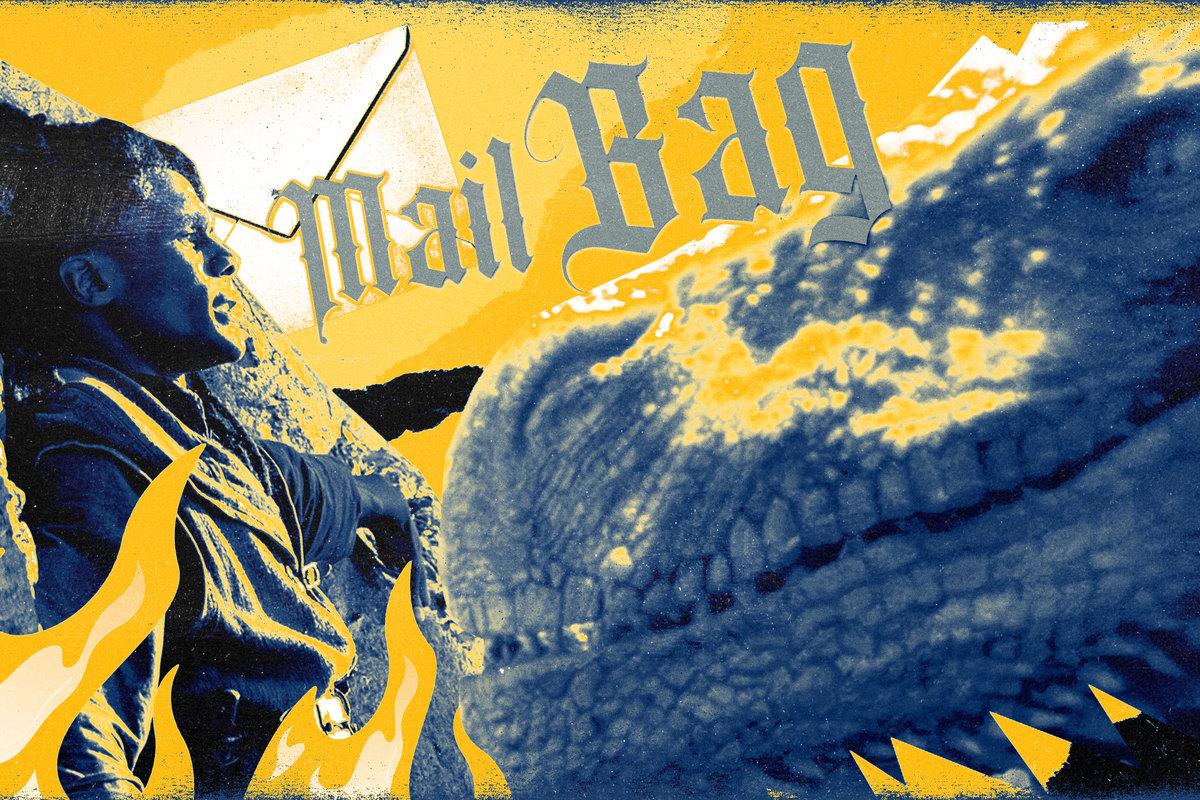‘House of the Dragon’ Episode 6 Mailbag: You Must Be This Targ to Ride
Spoiler-free answers to mostly dragon-related questions raised by the ‘Game of Thrones’ prequel’s sixth installment of Season 2, including Seasmoke’s new rider, dragon names and sizes, dragon duels, and more
Welcome to a jam-packed House of the Dragon mailbag. I received more reader questions after “Smallfolk” than any previous episode of Season 2.
Keep them coming! To appear in future editions of the mailbag, message me @zachkram on Twitter/X or at zach.kram@theringer.com each week after a new episode airs.
Today, we’ll cover numerous elements of dragonlore, a tricky military map, and more, including some quick hits to get through as many questions as possible.
Amy asks, “Do we know the lineage of the guy that got Seasmoke at the end?” And Jack asks, “How can Addam ride Seasmoke if he doesn’t have Targaryen blood?”
Addam is a bastard son of Corlys Velaryon. His lineage is a bit more complicated in Fire & Blood—he’s first considered Laenor’s bastard son, though everyone knows Laenor isn’t cheating on Rhaenyra with women, and eventually, Corlys admits he’s the true father.
Notably for dragonriding purposes, Corlys isn’t a Targaryen. And while Laenor’s mother, Rhaenys, was a Targaryen, as far as we know, Addam’s mother—canonically a shipbuilder’s daughter named Marilda—was not.
Here are four theories that could explain Addam’s bond with Seasmoke, ranked from tightest restrictions on who can ride a dragon to loosest:
1. Seasmoke made a one-time exception because of the unique way in which his bond with Laenor was severed. While George R.R. Martin’s story makes it clear that no dragon can be ridden by another human while its rider still lives, it’s also true that other than Laenor, no other character willingly abandons a dragon. (In Fire & Blood, Laenor is believed to be dead, so nobody questions why Seasmoke can take another rider; we know from the show that he faked his death and secretly fled for Essos.)
Given this unprecedented circumstance, perhaps Seasmoke accepted a non-Targaryen rider because Addam, say, had the same scent as Laenor, his half-brother.
2. One of Addam’s parents passed down Targaryen blood. Either his mother was a dragonseed or Corlys had Targaryen DNA mixed in with his Velaryon ancestry—a plausible outcome, given the longtime close relationship between the two Valyrian families. Even Aegon the Conqueror had a Targaryen father and Velaryon mother.
3. Targaryen ancestry isn’t necessary to ride a dragon, only the blood of old Valyria—so Corlys’s DNA alone is sufficient for Addam to hop aboard. If this were the criterion, then all Velaryons could claim dragons, but they never received the opportunity or access to make a previous attempt.
4. Anyone can ride a dragon regardless of Targaryen or Valyrian ancestry. When Jacaerys and Rhaenyra concoct their rider recruitment plan in “Regent,” Jace says the idea that a rider must be a “dragonlord” comes from “Valyrian histories, written to gild us in glory.” He and his mother hypothesize, in the moment, that these histories hide the fact that members of other noble houses with Targaryen ties—like the Darklyns—can become dragonriders.
But there’s another, farther-flung extrapolation of this idea: The notion that only Targaryens or Valyrians can ride dragons is pure propaganda, designed to both uplift the royal family as godlike and protect its power from other aspiring riders. A book character named Nettles pokes at this theory, but it seems likely that Nettles will be cut from House of the Dragon. (I won’t say any more about her for now, given the potential for spoilers.)
We might never learn which of the four possibilities explains Addam’s newfound bond with Seasmoke. I think the first three are more likely—but my personal opinion is that the fourth option is the most fun and nuanced, and I’m disappointed in Nettles’s likely excision for this reason alone.
Sean asks, “Why are the young dragons in House of the Dragon so much smaller than Dany’s dragons in Game of Thrones were by the end?”
There are some possible in-world explanations for this discrepancy. We know that dragons grow larger when they have free space to roam, which Drogon has in Meereen but many of Westeros’s dragons in the Dance era lack, thanks to their home in the Dragonpit.
Dragons also grow at different sizes and speeds because of individual variation, much like humans and animals of other species—Drogon was larger than Rhaegal and Viserion even before the latter two were confined in chains. Color might play a role here; it could be a coincidence, but the only three dragons known to have black scales are Balerion the Black Dread (the largest dragon on record), Drogon (seemingly huge for his age), and the wild dragon Cannibal (the largest of the wild dragons in Westeros).
A more mystical explanation concerns dragons’ apparent link with magic, which is still a largely unexplored mystery in Martin’s saga. If magic is slowly disappearing from the world in the decades leading up to the start of Thrones, then it would make sense that the Targaryen dragons shrink over time; as Tyrion observes in the first book, the skulls of the last dragon hatchlings (before Daenerys hatches hers more than a century later) are “no bigger than mastiff’s skulls.” But if magic then returns to the world during Thrones—which would explain why dragons can hatch again and why the White Walkers reemerge—perhaps dragon growth quickens accordingly. Drogon was also born via a magical fire, which may have added even more accelerant to his flames.
Or this is all just a matter of the difficulty in power scaling, because original Thrones wanted to portray its dragons as possessing overwhelming force and might, and then Dragon had nowhere else to go when depicting even stronger, mightier dragons. David Benioff and D.B. Weiss’s adaptation already took some liberties with its dragon presentation. Consider the scene in which Drogon rescues Daenerys from the fighting pit in Meereen. At this point, the book describes how Drogon’s “wings stretched twenty feet from tip to tip,” but his wingspan looks much larger in the show.
To be fair, more time passes in the show (about one year per season) than in the books (where Martin scrapped his plan for a five-year time jump), so Drogon had more years to grow in the former.
In other words, Drogon’s tremendous size in late-stage Thrones provided an excellent spectacle, as in the Loot Train Attack. But it also might have caused problems with the internal consistency of the world-building—because if Drogon is already that massive, then how does Dragon design dragons that are successively bigger while still allowing Vhagar, at the top end, to look remotely realistic?
Buff asks, “Are there dragon succession plans? If Vhagar dies, does Aemond go from having the most powerful weapon in Westeros to being just another guy with sick hair and a pointy sword?”
There is no dragon succession plan; no human in Martin’s story has bonded with multiple dragons. In A Dance With Dragons, when Daenerys is asked if she intends to ride her dragon children, she responds, “One of them. All I know of dragons is what my brother told me when I was a girl, and some I read in books, but it is said that even Aegon the Conqueror never dared mount Vhagar or Meraxes, nor did his sisters ride Balerion the Black Dread. Dragons live longer than men, some for hundreds of years, so Balerion had other riders after Aegon died … but no rider ever flew two dragons.”
However, Daenerys’s information might be too limited because it’s based on observed precedent rather than necessarily ironclad law. When most dragons die, after all, their riders die with them—as was the case with Arrax and Luke, then Meleys and Rhaenys. There haven’t been many tests of the multiple-mounts theory; in Thrones, Daenerys never tried to mount Rhaegal or Viserion after first riding Drogon. (In the books, she just took her first ride on Drogon, so readers don’t know if she’ll ever try to ride another. Come on, George!)
For what it’s worth, multiple other Targaryens in Martin’s story seem to think it’s possible to claim another dragon after losing their first. I can’t go into these details for spoiler reasons—but it would follow logically that if dragons can take multiple riders in the event of death, then the reverse should work just as well.
Evidence for this theory also comes via a comment from the author himself. In 2014, Martin wrote on his blog, “When the Black Dread died (of old age, not in war), [Viserys] did not take a second dragon”—the implication being that the king could have taken a second dragon if he wanted. This comment suggests that Viserys didn’t ride again by choice, not by rule. One imagines Aemond would make a different decision if he somehow lost Vhagar.
Nick asks, “What was the deal with Rhaena and the Lady of the Vale lying about a dragon? Which dragon?”
That surprise predator is a wild dragon named Sheepstealer (named for his diet), and it is much to George R.R. Martin’s chagrin that he’s hanging out in the Vale. In Fire & Blood, Sheepstealer lives on Dragonstone, but the author must have known this adaptation change was coming because he wrote in a big blog post just last week that his dragons are “not nomadic” and “have lairs on Dragonstone. … You won’t find dragons hunting the riverlands or the Reach or the Vale, or roaming the northlands or the mountains of Dorne.”
We’re already departing from book canon, wherein Sheepstealer lives on Dragonstone, but I hope his story is just as rewarding on the screen as it is in the text.
Thomas asks, “Are there standards on dragon naming (who names them, how they’re named)? There seem to be some that have Valyrian-sounding names (Arrax, Balerion, Vhagar) whereas others sound like straight-up pet names (Seasmoke, Sheepstealer).”
Speaking of Sheepstealer! He’s one of three wild dragons in Westeros, along with Cannibal and Grey Ghost, and it makes sense that they would all have “pet” names that describe their behavior because they aren’t known to be of Valyrian stock.
We know only a bit more about broader dragon-naming conventions. In A Clash of Kings, Daenerys says that the three dragons involved in Aegon’s Conquest—Balerion, Vhagar, and Meraxes—were “named for the gods of old Valyria.” We just discussed how Daenerys might not be a perfectly reliable narrator when it comes to dragon histories, but Fire & Blood offers support for this etymological theory. When Rhaenyra becomes a dragonrider, the text says she bonds with a “young dragon she named Syrax, after a goddess of old Valyria.”
Martin has published barely anything about the Valyrian religion, so it’s possible that other names like Vermax, Arrax, and Meleys come from that source as well. Similarly, another Targaryen dragon is named Morghul after the Valyrian word for “death,” as in valar morghulis.
Otherwise, dragon names are haphazard, possibly because they’re chosen by the children who bond with them. Fire & Blood directly states that Rhaenyra names Syrax, Laenor names Seasmoke (presumably because of his coloring), and another character (unidentified here because of spoilers) names a dragon Morning. This dynamic is reminiscent of the Stark kids with their direwolves: Five of the six name their pets for their physical appearance or a symbolic meaning, while a sixth chooses an admirable historical figure as a namesake:
- Robb: Grey Wind
- Jon: Ghost
- Sansa: Lady
- Bran: Summer
- Rickon: Shaggydog
- Arya: Nymeria, a famous Rhoynar princess
Maybe Rhaenyra and most of her kids are just big nerds who prefer to have a historical basis for their dragons’ names!
Patrick asks, “Why is the Crossing at the Twins so important to army movement in Westeros? A quick look at any publicly available map of Westeros shows that it’s nowhere close to the Kingsroad. Any army coming down from the North can easily avoid the Twins by marching straight down the Kingsroad towards the Trident. Crossing at the Twins made sense for Robb Stark as his destination was Riverrun and the Westerlands, but in House of the Dragon the Northern army is likely headed for Harrenhal, making the need to cross at the Twins nonexistent.”
In Fire & Blood, although Cregan Stark agrees to an alliance with Jacaerys, the first wave of Northern troops to come to Rhaenyra’s aid hails from House Dustin rather than House Stark. They’re very cool: They carry “axes, mauls, spiked maces, and ancient iron swords,” and they call themselves the Winter Wolves after their homeland and fierceness. And, most importantly for the purposes of both this question and Jace’s trip to the Twins, they march from Barrowton, home of the Dustins, rather than Winterfell.
Notice Barrowton’s northwestern placement on this slice of Westeros’s map. While Winterfell (at the very top of this image) is mostly a straight ride down the Kingsroad to Harrenhal (at the very bottom), the shortest path from Barrowton (near the top left) would head southeast through the Twins (middle left).

They follow that route in Fire & Blood and join forces with 200 knights and 600 foot soldiers from House Frey while they’re at it. So I suspect that House of the Dragon retained that general geographical structure while shifting the actual characters involved from the unfamiliar Dustins to the familiar Starks. (The most important Dustin in the main book series is Lady Barbrey, yet she never appears in Thrones.)
Jonathan asks, “What are the determining factors in dragon-on-dragon combat? Is it simply a question of which dragon is older/bigger/faster, or does the dragonrider himself/herself play a role? Essentially, is this a Top Gun situation, where Tom Cruise is such a good pilot that he’d win no matter how underpowered his aircraft is, or how many aircraft he’s going against? If not, and it’s all up to the dragon, what factors matter the most?”
Thank you, Jonathan, for the opportunity to plug a video we made at the end of Season 1 of House of the Dragon, which includes lots of details about dragon combat. It even has a fortuitous Top Gun reference!
I won’t rehash all the tidbits here, except to say that the key takeaway—most dragon duels are decided up close by claws and teeth, rather than from a distance by fireballs—manifested at Rook’s Rest as well.
The question about rider vs. dragon is interesting but not entirely answerable at this point in the story because fiercer fighters are attracted to fiercer dragons, so the variables confound. Aemond rides Vhagar, not piddly little Stormcloud. And in the last dragon duel in Westeros before the Dance—during the succession battle between Maegor the Cruel and one of the many Aegons—the better human fighter also rode Balerion the Black Dread, the superior dragon.
There is likely some rider strategy that could sway the result of a dragon battle, such as searching for a height advantage—diving from above is easier than climbing from below—and choosing when to hide, flee, or fight.
But it seems as if the outcome mostly comes down to the dragons themselves. Remember, Daemon is probably the most accomplished individual fighter in Westeros right now, and he rides the formidable Caraxes. And even he says early in Season 2 that he can’t challenge Aemond and Vhagar without help from a second dragon—because Vhagar, the “hoary old bitch,” is too daunting an opponent to take on alone.


